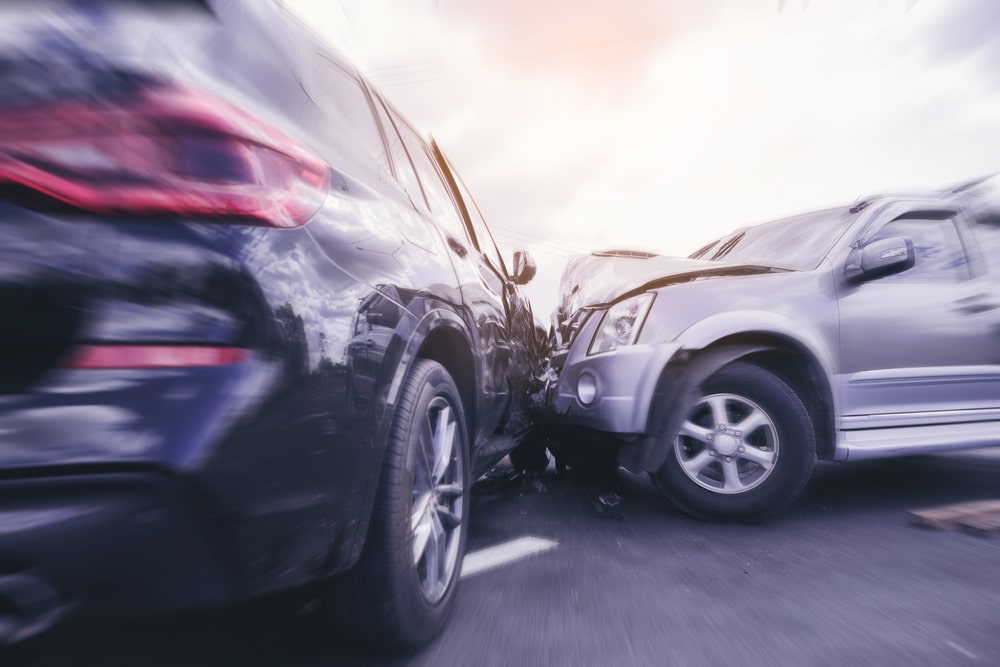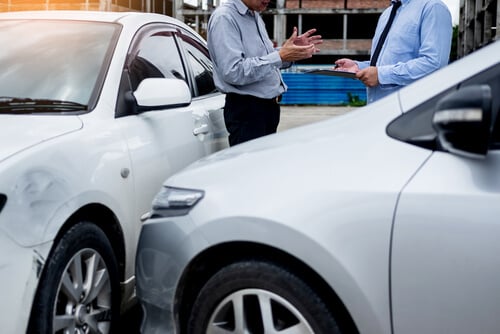Sideswipe collisions can unfold in many ways, depending on the environment and driver behavior. These car accidents often occur on multi-lane roads when one vehicle drifts out of its lane into the path of another. A car may contact the side of another vehicle and push it off track or cause further collisions with barriers or other cars.
On highways or major roads, the consequences of a sideswipe can escalate, particularly if high speeds or large vehicles like trucks are involved. A vehicle may spin out, lose control, or even roll over, putting passengers at considerable risk of harm.
Accidents involving vehicles traveling in opposite directions can be even more dangerous. These collisions often occur when a driver crosses the centerline or fails to stay in their designated lane.
Here is everything you need to know about what happens if you get sideswiped:
Common Misconceptions About Sideswipe Accidents
Sideswipe accidents are often misunderstood, leading to confusion about their severity and the steps needed after such a collision. Clearing up these misconceptions can help drivers better protect themselves and build stronger cases if involved in one.
Misconception 1: Sideswipe Accidents Are Always Minor
Many people assume that sideswipe accidents cause only minor damage. While some collisions may result in little more than a scuff or dent, others can be quite serious.
A sideswipe can force a vehicle to lose control, hit other objects, or even roll over if high speeds are involved. Injuries like whiplash, broken bones, or even traumatic brain injuries are not uncommon.
Misconception 2: The Other Driver Is Always at Fault
It’s easy to believe that the person who sideswipes another car is automatically to blame, but fault isn’t always that straightforward. Sometimes, multiple factors contribute to a sideswipe, such as a driver failing to signal a lane change while the other driver speeds up or drifts into another lane.
Florida’s comparative fault laws consider shared responsibility, which can influence the outcome of insurance claims or lawsuits.
Misconception 3: Insurance Will Fully Cover All Damages
While Florida’s no-fault insurance laws provide some financial protection through personal injury protection (PIP) coverage, many drivers mistakenly think it covers everything. PIP often has limits that may not account for severe injuries, long-term medical costs, or extensive property damage. Victims may need to pursue claims beyond their PIP coverage for significant losses to recover the remaining costs.
Misconception 4: Witnesses Are Not Necessary
Some assume that sideswipe accidents are straightforward and don’t need witness accounts. However, when fault is disputed, supporting testimony from neutral witnesses can help clarify what happened.
Witnesses may recall details about which car failed to signal, who initiated a lane change, or whether aggressive driving occurred. Their accounts can strengthen a victim’s case significantly.
Misconception 5: Reporting the Accident Is Optional
Some drivers believe they can skip reporting the accident if there isn’t significant damage or obvious injuries. This can be a costly mistake. Filing a police report and notifying insurance companies is essential for legal and insurance purposes. Official documentation aids in determining fault and ensuring claims are processed smoothly.
Addressing these misconceptions, drivers can approach sideswipe accidents with greater clarity. Knowledge of potential dangers, proper post-accident steps, and the claims process can make a significant difference during recovery and while seeking compensation.
Common Causes of Sideswipe Accidents in Florida

Sideswipe accidents can happen for many reasons, but most are due to driver negligence or error.
Below are some of the most common causes:
- Failure to check blind spots
Blind spots can easily hide another vehicle next to you. Drivers who change lanes without checking their mirrors or turning their heads to confirm the lane is clear create a serious risk. - Distracted driving
Reading texts, talking on the phone, or adjusting in-car controls may distract someone long enough to drift into a neighboring lane. - Impaired driving
Drivers under the influence of alcohol or drugs may experience impaired judgment and coordination, leading to unsafe lane changes or road drifting. - Aggressive driving
Actions like weaving between lanes, speeding, and intentionally cutting off other cars can cause sideswipes. Aggression on the road increases the chances of all kinds of accidents. - Fatigue
Tired drivers may unintentionally veer from their lanes when battling drowsiness, especially during long commutes or overnight drives. - Weather conditions
Rain, fog, and slick roads can make staying in a lane more challenging. Poor visibility can also make it harder to spot other vehicles nearby.
Florida’s bustling highways and interstates make the state a hotspot for sideswipe accidents. These incidents are particularly common in urban areas like Miami, where heavy traffic, merging, and faster speeds contribute to frequent collisions.
Injuries Commonly Associated with Sideswipe Accidents
Regardless of whether you’re the driver or a passenger, the sudden force of a sideswipe accident can cause injuries.
People involved in these crashes often report injuries such as:
- Whiplash
The abrupt motion of a collision may lead to neck strain or soft tissue damage in the neck area, which is commonly referred to as whiplash. - Spinal injuries
Even minor collisions can cause disk herniation or other spinal issues, which may result in pain, mobility difficulties, or long-term disability. - Head injuries
Victims may strike their head on a car window or dashboard during a sideswipe. The force can result in concussions or more serious conditions like a traumatic brain injury (TBI). - Shoulder and arm injuries
Drivers often brace for impact during a collision. Shoulder and arm injuries, including torn ligaments or fractures, are common as a result. - Broken bones
The jolt of a collision can lead to fractures, particularly in less-protected areas like ribs and collarbones.
Medical records are vital when documenting injuries sustained in a sideswipe accident. Seeking medical attention promptly is essential, even for those who believe they walked away unhurt.
Legal Considerations in Florida Sideswipe Accidents
Florida has a complicated legal system for assigning fault in car accidents, including sideswipes. It’s imperative to understand the state’s relevant laws and guidelines.
No-fault insurance laws
Florida operates under a no-fault insurance system. Drivers must carry personal injury protection (PIP) coverage, which helps cover medical expenses and lost wages, regardless of who caused the crash. However, victims may file lawsuits outside of the PIP system for more severe injuries to recover additional damages.
Comparative fault in Florida
Florida also applies the principle of comparative fault. This means that if you are partially responsible for causing the accident, your compensation may be reduced based on your percentage of fault.
For example, if you are found 20% at fault, any damages awarded will be reduced by 20%.
Statute of Limitations
Florida laws impose time limits on filing car accident claims. Victims of a sideswipe accident generally have four years from the collision date to file a personal injury claim.
Failing to file within this window could result in losing legal rights to compensation. Wrongful death claims have an even shorter two-year window.
Liability in Sideswipe Accidents
Determining who is liable in a sideswipe accident can be challenging without proper investigation.
Liability often rests with drivers who:
- Drift into another lane without signaling.
- Fail to yield during merging or lane changes.
- Drive aggressively or under the influence of alcohol.
- Are distracted or fatigued while driving.
There are also instances where liability may extend to additional parties. Poor road maintenance or faulty road designs can contribute to accidents, especially if improper lane markings confuse drivers.
Mechanical failures, such as a faulty steering system, may also place some liability on a vehicle manufacturer.
Steps to Take in the Days and Weeks After a Sideswipe Accident
The days and weeks following a sideswipe accident are crucial for protecting your health and legal rights. Taking the right steps ensures that you document the accident properly, minimize financial burdens, and receive any compensation you are entitled to.
Here’s how to stay on track during this time.
Seek medical follow-ups
Even if you received initial treatment, schedule follow-up visits with your doctor to monitor your recovery. Symptoms of some injuries, like concussions or whiplash, may not appear immediately.
Discuss any lingering pain or discomfort with a healthcare provider, and follow their recommendations for additional treatment or therapy. Keeping all medical appointments and collecting records is essential for your case.
Notify your insurance company
Contact your insurance company to report the accident and begin the claims process. Provide any documentation they request, such as photos or the police report. Be honest about the details, but avoid making assumptions about fault. Stick to the facts and allow insurance adjusters to handle liability questions.
Review your insurance policy
Review your policy to understand what coverage is available to you. Florida’s no-fault system means your personal injury protection (PIP) should cover medical expenses and lost wages up to a certain limit. You may need to explore other legal options if damages exceed your coverage.
Gather additional evidence
Continue documenting the aftermath of the accident. Take detailed photos of ongoing vehicle damage, any visible injuries, and receipts for medical or repair expenses. If your injuries limit your mobility or work capacity, keep a record of these difficulties as well. Start a journal to track the ways the accident affects your daily life.
Collect witness information
If you didn’t get witness information at the scene, try reaching out to anyone who might have seen the crash, such as nearby business employees or residents. Witnesses can provide statements that help clarify how the accident occurred and support your account if liability is disputed.
Maintain all accident-related documentation
Keep all paperwork related to the accident in one place. This includes medical bills, car repair estimates, correspondence with insurance companies, and police reports. Staying organized makes it easier to manage your claim and ensures nothing important is overlooked.
Research potential legal claims
Consider filing a personal injury claim if the accident resulted in serious injuries or extensive property damage. Florida law allows injured parties to recover damages beyond PIP limits in severe harm cases. Speak with a legal professional to explore your options and determine the best course of action.
Monitor communication from insurance companies
Insurance companies representing other drivers involved may contact you. Be cautious when speaking with them. Insurance adjusters may try to minimize their liability by offering a quick settlement.
Avoid agreeing to anything without fully understanding the long-term medical and financial effects of the accident.
Repair your vehicle
Once the insurance company approves your claim, arrange for professional repairs. Some insurers may work directly with repair shops to streamline the process. Keep receipts and invoices from all service providers, as they may be needed for reimbursement.
Stay mindful of deadlines
Florida law sets strict limits for filing claims. Personal injury claims must usually be filed within four years of the accident date. Wrongful death claims have a shorter two-year timeframe. Make sure you stay aware of these deadlines to avoid jeopardizing your case.
Taking these steps in the days and weeks following a sideswipe accident can better protect your health, finances, and legal rights. Acting promptly will give you the best chance of recovering fully and reducing long-term stress.
Seeking Legal Support After a Sideswipe Accident

A sideswipe accident can turn life upside down. The consequences may be long-lasting, whether it’s mounting medical bills, lost wages, or emotional distress.
Seeking the right legal support is important to receive fair compensation and hold negligent parties accountable.
Contact Englander Peebles to discuss your case and explore your options. A dedicated team can guide you through the process and help you pursue restitution for your losses. Reach out today at 954-951-8717 for a consultation and take the first step toward justice.



